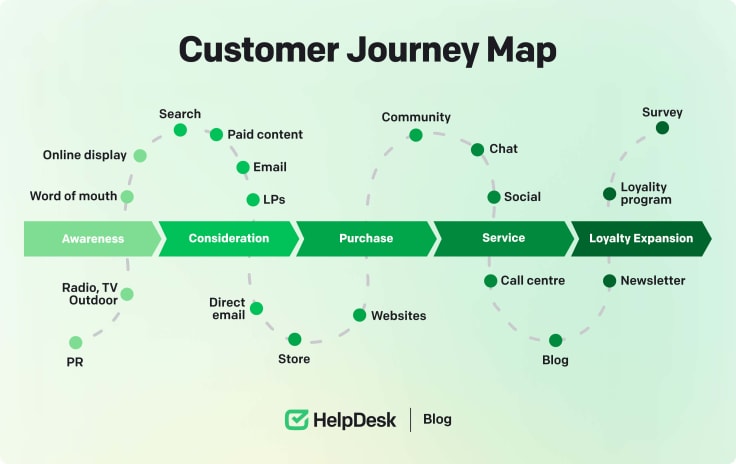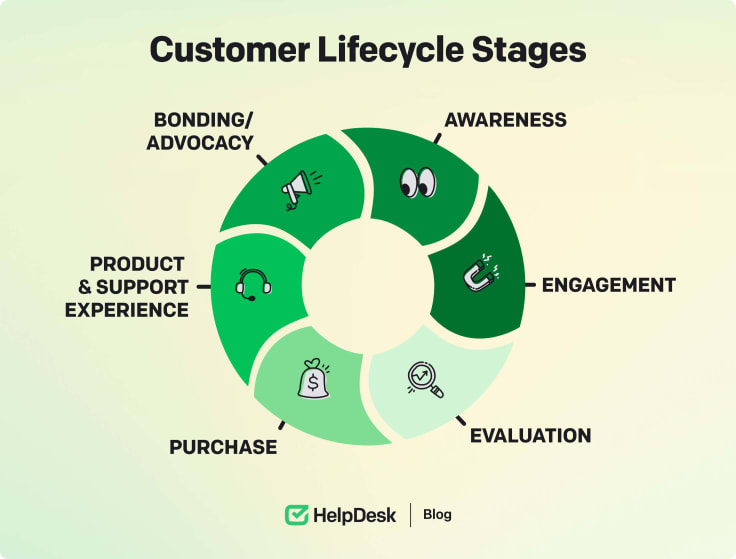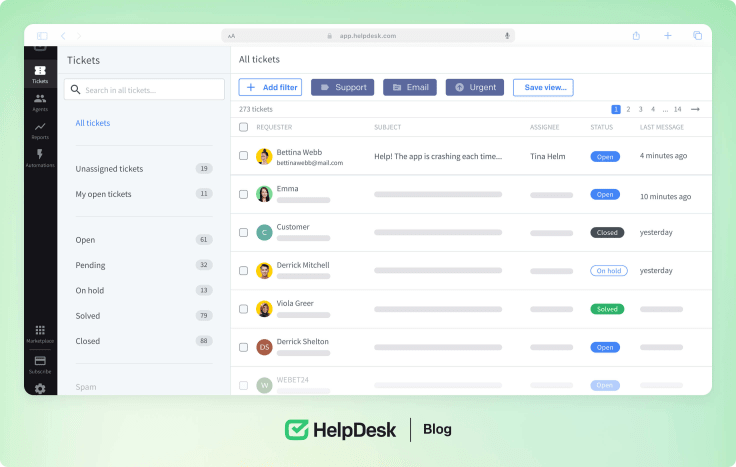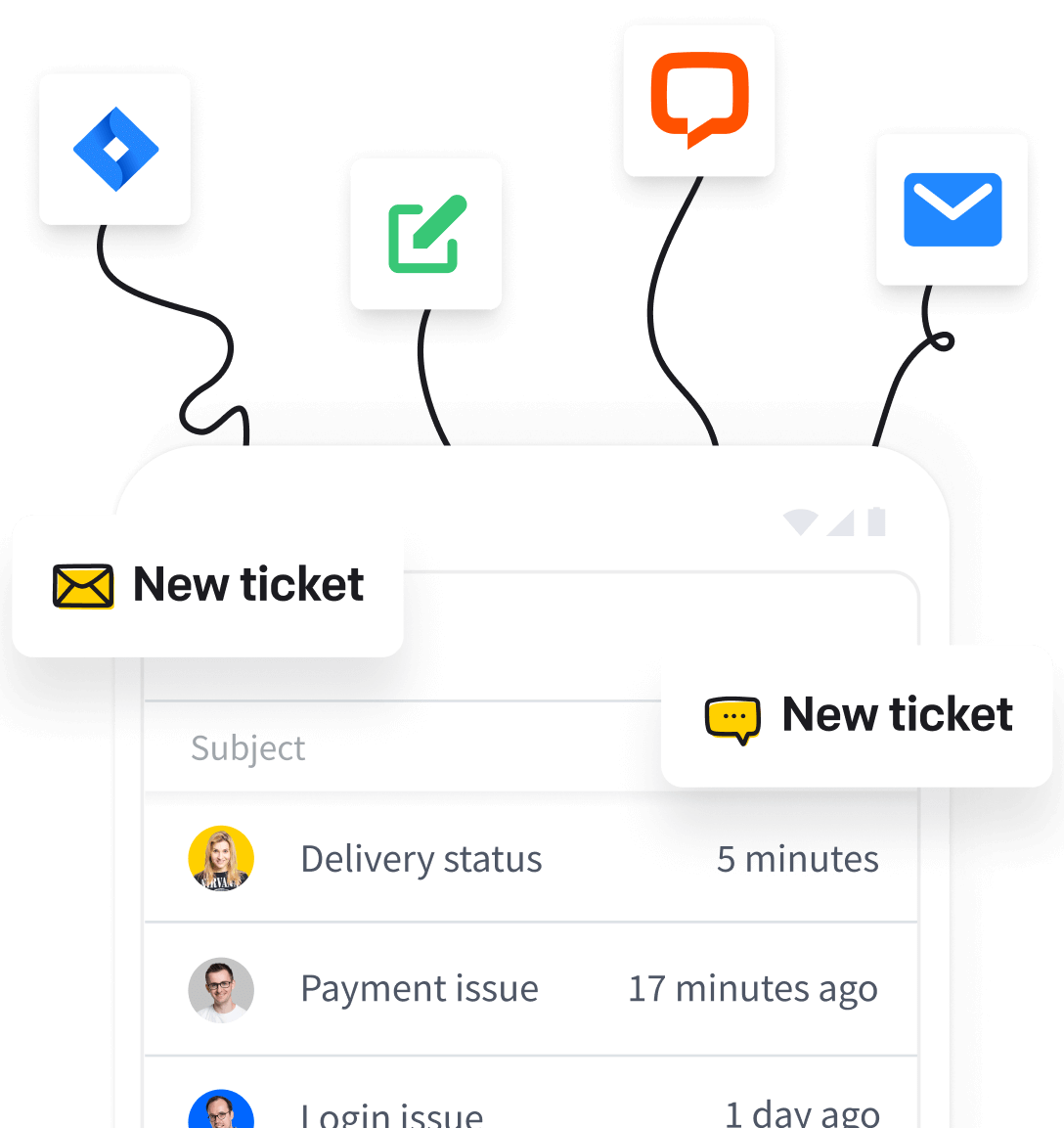Zuzanna Bocian

We all need customers to run our business. That’s the ultimate truth. However, it’s essential to recognize that, on average, a successful business still loses 15% to 20% of its customers annually (source). It is better to prioritize creating a long-lasting customer relationship rather than solely focusing on short-term transactions.
This is where customer lifecycle management helps!
Implementing customer lifecycle management strategies allows you to analyze your customer journey and identify points for improvement. You can then shape your marketing strategies to increase customer engagement and create long-lasting relationships.
Let’s dig in!
What is a customer lifecycle?
A customer lifecycle is the complete journey a customer goes through, from discovering your brand to making a purchase, using the product, and remaining loyal.
The customer journey contains five stages:

Understanding the customer lifecycle journey is essential for all successful businesses. If you complete any stage of the customer cycle, they’ll likely be satisfied and may not opt for your services again.
What is customer lifecycle management?
Customer lifecycle management (CLM) tracks a customer’s journey stages and assigns specific metrics to each stage. It also involves monitoring those metrics to analyze and optimize the overall performance of your customer lifecycle strategies to reduce churn rate.

Stages of customer lifecycle management
It’s important to understand the five stages of customer lifecycle management to effectively manage the customer journey.
Awareness
In the first stage of the customer journey, the customer becomes aware of your product. This can happen in several ways, such as through targeted advertising or social media platforms.
Word-of-mouth referrals are also significant in this stage, as 23% of people share their favorite products with friends and family (source).
During the awareness stage, the main objective is to attract the attention of potential customers and introduce them to your products, arousing their curiosity about what your brand offers. You can use various strategies to raise awareness, such as search engine optimization (SEO) and social media marketing.
Consideration
The consideration stage is when customers research their options and contact you for more information about your products via channels such as video chat, phone calls, or email.
Your customer service team should give customers informative, valuable, and relevant content and provide self-service resources and tools to aid them in decision-making. For instance, you can provide product tutorials, how-to guides, online courses, and testimonials throughout the sales funnel to deepen a customer’s interest in your offerings.
Manage your customers' questions effectively and convince them to use your services with HelpDesk ticketing software. 🚀 Join a free 14-day trial now!

Purchase
The purchase stage is when a potential customer decides to purchase a product or service. To convert one-time customers into long-term ones, groundwork must be laid.
This may involve optimizing your website for smooth navigation and offering transparent pricing with clear refund information. You should prioritize providing a seamless checkout and purchasing experience, as a suboptimal checkout process is a leading cause of cart abandonment (source).
Retention
The fourth stage of client lifecycle management is the customer retention stage. At this point, your business should focus on developing long-term customer relationships.
You can gather customer feedback about how your products or services have helped them and if anything needs improvement. It is important to take their suggestions positively and work towards enhancing their overall experience.
Moreover, you should provide personalized support and value-added services to ensure customer satisfaction and engagement. Investing in the retention stage will help customers stay loyal to your brand, make repeat purchases, and even promote your business to others.
Learn more about customer retention in our latest Learning Space Guide! 🧑🚀

Loyalty
Loyalty is the final stage of the customer lifecycle when returning customers advocate for your brand. These loyal customers make repeated purchases from your brand and encourage others to try your product and bring new business.
You should always strive to meet and exceed customer expectations to maintain brand loyalty. You can reward loyal customers through giveaways, loyalty programs, and other discounts. This will make them feel valued, ultimately increasing the sales funnel and your ROI.

Benefits of effective customer lifecycle management
Let’s see why customer lifecycle management is important.
Improved customer retention and loyalty
Good customer lifecycle management is crucial to improving customer retention and loyalty. You can gain the trust of your customers by providing personalized experiences, timely support, and ongoing engagement.
When customers feel valued and appreciated, they’re more likely to choose your brand over others, even if there is competition. This loyalty and retention can become a dependable source of revenue for your business, which is important for achieving long-term success.
Increased customer lifetime value
The lifetime value of customers refers to the amount of value they bring to your company throughout their relationship with your business. In other words, it’s the total revenue you earn from a customer during their time as your customer.
Managing the customer lifecycle can increase your overall customer lifetime value (CLV) by allowing you to understand their needs and recommend relevant products and services. Customers are more likely to explore other products that align with their interests when satisfied, leading to repeat business and a higher CLV.

Enhanced ability to cross-sell and upsell
Cross-selling and upselling are strategies that help businesses generate more revenue. In 2020, around 80% of US businesses reported using cross-selling and upselling to increase their sales (source).
Upselling encourages customers to buy a higher-end product, while cross-selling suggests complementary products. Both methods can attract potential customers and improve their buying experience.
Better customer experiences lead to positive word-of-mouth
When you actively interact with customers during the engagement and purchase stage, you provide them with a positive shopping experience. In addition, the straightforward website navigation and smooth checkout process contribute to a smooth customer journey.
This results in high customer satisfaction, and they tend to share their good experience with friends and family, both online and offline. Your brand looks more credible due to these word-of-mouth endorsements, attracting new customers and expanding your customer base.
Data-driven insights for strategic decision-making
With effective customer journey tracking, businesses can get various data-driven insights. For example, you can analyze customers’ data to discern valuable patterns and trends, such as which products are popular in a particular customer segment.
Moreover, you can get an idea of what advertisement platforms yield the best results. This information lets you improve your products and adjust your marketing strategies to meet customer demands.
Key components of customer lifecycle management
Now that you know the customer lifecycle stages and CLM benefits, let’s discuss the key components of managing the customer lifecycle effectively!
Customer segmentation
Firstly, you must segment your customers into groups based on their shared characteristics, behavior, and preferences.
For example, a telecommunication company may segment its customers into three categories: “frequent travelers,” “budget-conscious users,” and “business professionals.” The purpose of this division is to offer consumers with personalized offers and services.
Personalized marketing
Personalized marketing offers customers tailored promotions and communications based on their preferences and needs. Personalization can take various forms, such as customized emails, targeted advertising, and product recommendations.
Imagine that a retail business can use a customer’s previous purchasing history to provide them with personalized product recommendations. This entices the customers to make a purchase, promoting business growth.
Feedback and improvement
You can collect feedback by conducting surveys or sending follow-up emails to customers asking about their experience with your product. Customer feedback gives you insight into how your offering has positively impacted them and what improvements they suggest.
For instance, a software company can request reviews from users about the usability of their product and any bugs encountered. This feedback can help the business prioritize product enhancement and updates, ultimately improving customer satisfaction.
Technology and tools
The fourth component of customer lifecycle management revolves around picking and using the right technology and tools. Here are some tools that you need for CLM:
CRM systems
Customer relationship management (CRM) is a technology that helps you keep track of all customer communications and nurture relationships with leads.
CMS
A content management system (CMS) allows you to create, manage, and modify content on your website without any technical knowledge. Using CMS, you can leverage search engines to reach potential prospects and provide them with tailored offers.
Predictive analytics
These analytics use statistics and modeling techniques to forecast demands based on previous or available data or trends. In CLM, predictive analytics tells you about the demand for a product and notifies you about changing consumer preferences.
Implementing customer lifecycle management
The implementation of the customer lifecycle management platform isn’t a one-step process; instead, it involves various steps:
Identifying target customer segments and their needs
Firstly, you should identify your target audience, such as who they are and how your products can benefit them. The buyer persona varies for each brand, but a few common characteristics to look at are:
-
Are they interested in your products?
-
Do they have the capacity to pay your set prices?
-
What are their demographics? (Age, gender, industry, etc.)
Once you’ve understood your target audience, divide them into segments based on their pain points and interests.
Let’s assume you run an athletic shoe brand. You create two segments based on your customers’ preferences: fitness enthusiasts prioritizing performance and casual users valuing style and comfort. It’s important to understand the needs of both segments to curate your marketing strategies and develop your products accordingly.
Mapping the customer journey
Once the target audience is identified and segmented, you should map out each segment’s customer journey. Mapping involves understanding a prospect’s various interactions or touchpoints with your brand throughout their lifecycle.
Some pre-purchase touchpoints include social media, company blogs, advertisements, and testimonials. At the same time, post-purchase or during-purchase touchpoint interactions involve conservation with the sales team and CSAT surveys.
Having information about the complete individual customer journey model allows you to improve the decision-making process for customers at each touchpoint.
Developing targeted strategies for each stage of the lifecycle
With a clear understanding of your customer’s segments and journey, you can create personalized buyer interactions for each lifecycle stage. You can offer:
-
Promotions to new customers: You should give special discounts and incentives to attract new customers and encourage them to purchase your products or services.
-
Hyper-relevant solutions to potential prospects: This involves providing personalized solutions to address customers’ specific needs when considering investing in your services.
-
Discounts to reward existing consumers: Rewarding loyal customers via different discounts and incentives is a good token of appreciation. These vary from coupon codes to loyalty programs and discount vouchers.
Key metrics and KPIs to track
Lastly, you should focus on measuring the success of your lifecycle management initiatives. Some key metrics that help you in this are:
-
New and repeat orders: How many new clients are you acquiring? Are older clients finding your products worthy, and are there repeat customers?
-
Upsells: Are premium choices available for a product? Do customers upgrade their choices to opt for a high-end version of the product?
-
Cross-sells: Are clients adding other complementary products or options to their cart? If yes, how many consumers are purchasing add-on products?
-
Customer churn: How many customers stop doing business with your brand after the first purchase? Is your cart abandonment rate high?
-
Usage frequency: How often does a visitor add a product to their cart?
-
Loyalty: How many customers recommend your products or services to their friends and family
-
Advocacy: What’s the number of positive reviews from your customers? Are your customers sharing information about your products with friends or family? If there’s a Refer a Friend incentive, how many people have used it?
Keeping track of all these key metrics gives you an idea of the effectiveness of your CLM efforts. If something isn’t going well, you can optimize client lifecycle management practices to see positive results.
🦸Take care of your customers and enhance your support team. ✅ Learn about "Key Metrics for Measuring Customer Support" in the Learning Space Guide!
Measuring and optimizing CLM ROI
To measure the CLM ROI, you should look at the rate of customer retention and conversion before and after implementing CLM practices. If your overall business revenue has increased after applying CLM methodologies, it indicates a good return on investment.
Optimize CLM ROI
However, if your ROI could be better, you can do a few things to optimize it.
-
Leverage data analytics tools to get insights into user behavior and shape CLM strategies accordingly.
-
Track key metrics like customer acquisition cost, churn rate, retention rate, and more.
-
Test different CLM offers and target messages to a group of people to see which one yields the best results and go with it.
You can also try personalized marketing campaigns based on customer segmentation. This will provide them with increased engagement, better customer lifetime value, and overall high ROI.
Top 5 software solutions for customer lifecycle management
The primary function of customer lifecycle software is to automate many steps of a CLM process. It provides tools for analyzing each customer’s data.
So, you’re free from the hassle of manually tracking customers’ names, purchase history, and preferences. In addition, it also offers features that aid in customer retention.
Factors to consider when purchasing customer lifecycle software
Here are some factors that you might consider when purchasing a customer lifecycle tool to ensure you invest in the right product:
Size and nature of your business
First things first – consider the size and nature of your business. If you run a small to medium-sized business, you can easily select cost-effective and simple CLM software that meets your specific needs. However, large companies that handle complex tasks look for scalable tools.
Integration and automation
Another factor to consider is its ability to integrate into your existing business systems. These include CRM software, marketing tools, and ecommerce platforms. In addition, you should make sure the software can automate repetitive tasks such as lead scoring and email marketing.
Ease of use
The software should be very easy to use as it directly impacts an employee’s productivity. So, search for a CLM tool with a user-friendly interface and smooth workflows. Also, ensure the software provider offers tutorials on product usage and efficient customer service.
5 CLM software to try
Now, let’s discuss the various CLM systems you can try for your business!
HelpDesk
HelpDesk is a ticketing system that offers a seamless solution for managing all stages of your customer journey. It boasts intuitive automation features, eliminating the burden of repetitive tasks and allowing your customer service team to offer an exceptional support experience.
This software automatically routes tickets to the concerned departments, ensuring customer inquiries are correctly answered. Each customer inquiry or issue is assigned a unique ticket, making it easier to manage and resolve thanks to ticket management features. It offers asynchronous communication between agents and customers, leveraging various channels like email, chat, and social media.
The purpose is to maintain a smooth communication line and offer timely assistance, which is crucial for existing customer satisfaction and retention. What truly sets HelpDesk apart from other CLM software is that you can easily integrate it with third-party apps to complement its performance. These apps include Slack, Jira, and more.
Try HelpDesk for free and boost your support team efficiency. 💻 Join now!
HubSpot
HubSpot is another software that offers a complete CLM solution. It’s also cloud-based and can easily integrate with third-party apps like Gmail, Outlook, Zoom, Shopify, etc. It collects information about your customers, making it easy for you to segment them. Furthermore, it can become a key component of your overall marketing automation.
This tool can help you with customer lifecycle analysis, monitoring all CLM key metrics, and building strong customer relationships. Its email marketing automation tool is a standout feature, automatically sending an interaction and follow-up message to boost your pipeline.
EngageBay
EngageBay is amazing CLM software that offers a 360-degree view of customers’ experiences. Its practical sales automation tools allow you to keep track of all your lost and won deals.
In addition, this software provides you with information on your best-performing marketing content and comes with a minimal price tag. You can enjoy integrations like Xero, Shopify, QuickBooks, Twilio, and more with EngageBay.
ChurnZero
Let’s discuss ChurnZero, an incredible software for managing the customer lifecycle for a subscription business. It comes with an intuitive dashboard featuring all business-relevant KPIs. So you can get an idea of what’s working for your business and where’s room for improvement. On top of that, this exceptional CLM solution is suitable for mobile usage, both iOS and Android. You get real-time alerts regarding customer inquiries for timely resolution.
SalesForce Marketing Cloud
The final option on our list is SalesForce Marketing Cloud. This platform comes with a Customer 360 feature that easily integrates with Slack. SalesForce Marketing Cloud lets you connect with your customers across various touchpoints and track a complete customer journey.
Then, there’s the SalesForce Customer Data Platform, which gives insights into client data. You can use this information to segment and nurture customers with personalized buyer interactions. It also provides you with information about the performance of your social media marketing campaigns through AI and ML analytics.
Future trends in customer lifecycle management
The CLM process will change in the upcoming years due to the evolution of technology. Let’s see some future trends in CLM:
Role of AI and ML
A significant trend that will impact the future of CLM is the increased utilization of artificial intelligence (AI) and machine learning (ML) technologies. These advanced technologies will help businesses analyze vast amounts of customer data with unmatched speed and accuracy, providing better insights into customer behavior and preferences.
This, in turn, will lay the foundation for more targeted marketing strategies. Additionally, AI will automate many routine tasks, enabling businesses to focus more on shaping customer experience and enhancing overall satisfaction.
Importance of data privacy and ethical considerations
Data plays a crucial role in the CLM processes. As businesses accumulate vast amounts of data, the significance of customer data privacy and ethical considerations will become even more critical.
To ensure customer data’s safety, companies must comply with the General Data Protection Regulation (GDPR) and prioritize implementing robust safety controls on their systems to prevent cyberattacks. This increased emphasis on data privacy will help build customers’ trust in a brand, leading to long-term and sustainable relationships.
Summary
Customer lifecycle refers to a customer’s first interaction with your brand and post-purchase journey. CLM isn’t a one-step process. Instead, it covers various aspects and can become integral to your marketing automation.
You need to identify your audience and segment them. Afterward, you should target them with personalized marketing and recommendations to make them your returning customers — the benefits of CLM range from increased customer loyalty to better overall ROI.
It also provides opportunities for cross-selling and upselling, ultimately bringing you more loyal clients. Some of the best CLM software to invest in are HelpDesk, HubSpot, and Sales Marketing Cloud. However, as technology evolves, you should monitor CLM’s future trends. AI and ML will take the business world by storm, while more focus will be on data privacy to protect customers’ personal information.


Get the cheat sheet for solving customer tickets
Join our newsletter to receive your cheat sheet and other amazing content directly in your inbox.
Success! You're one click away from the cheat sheet 👇
Open now